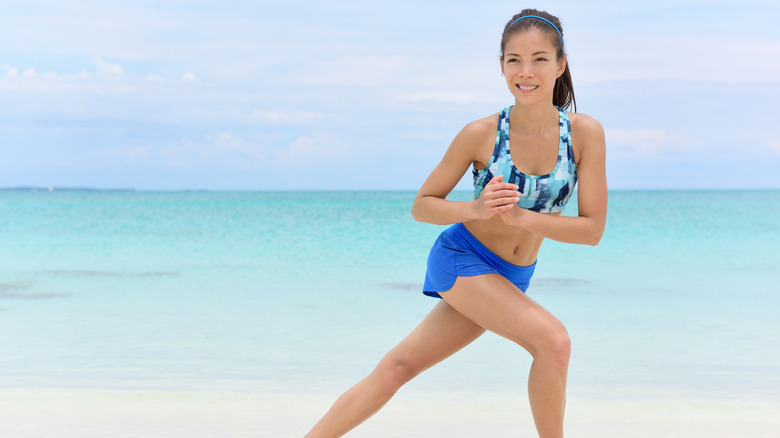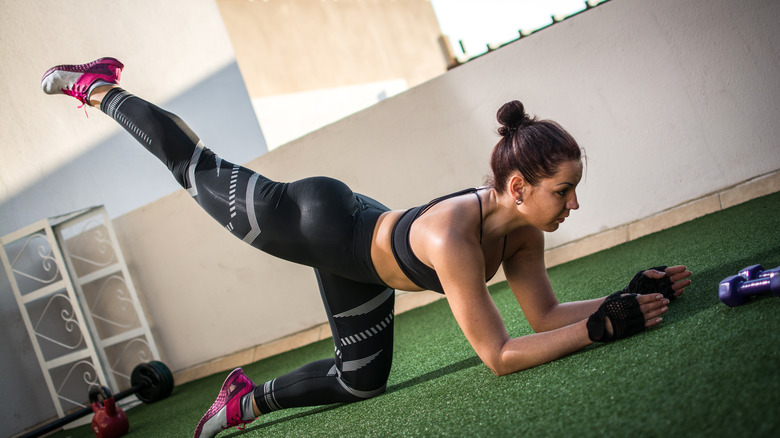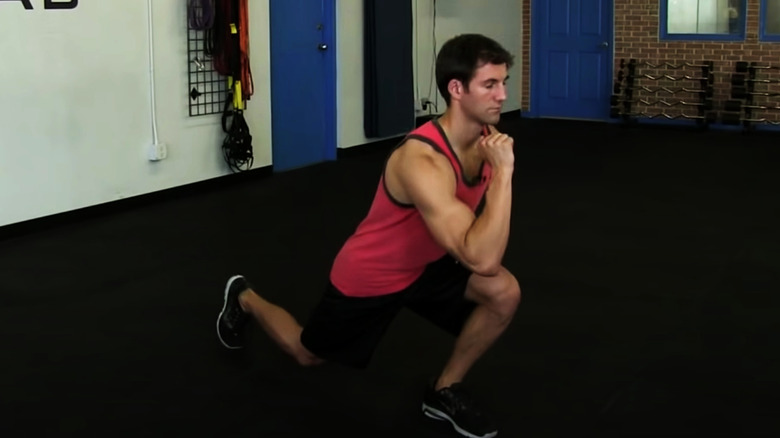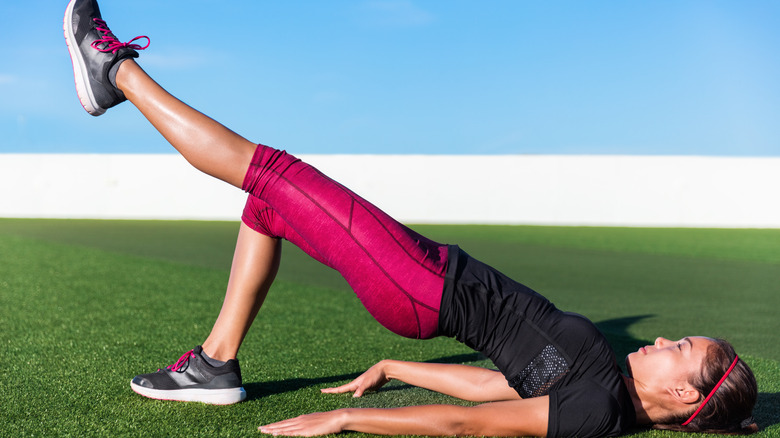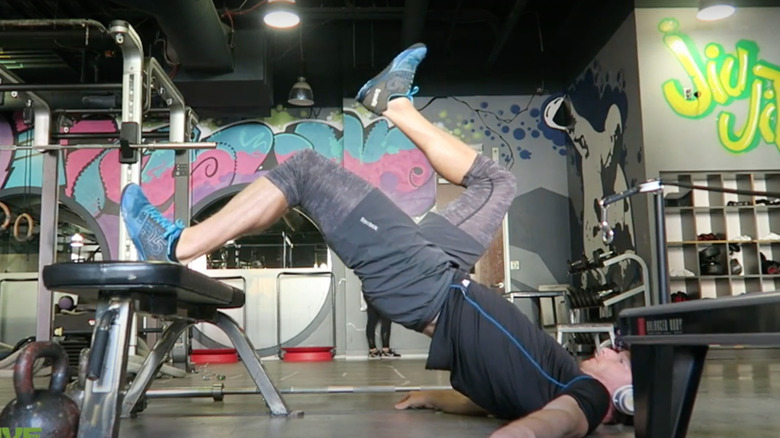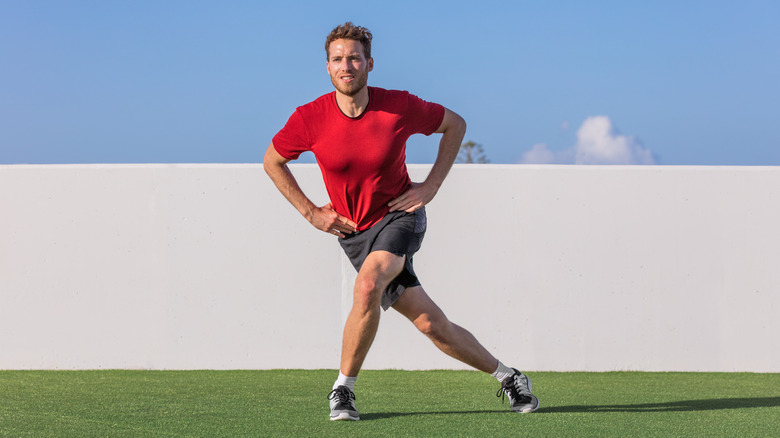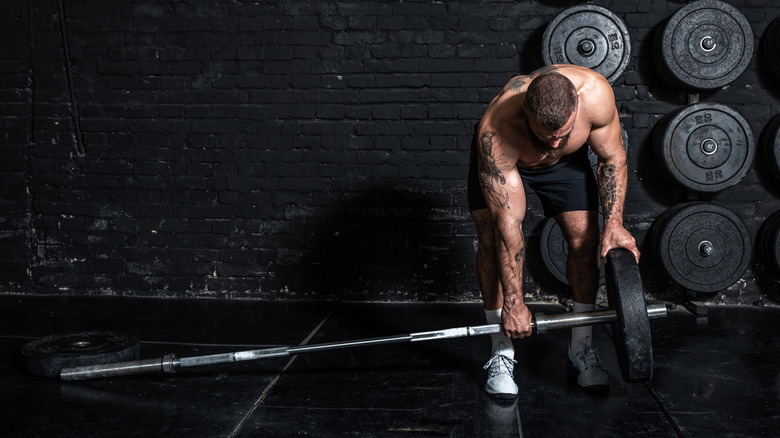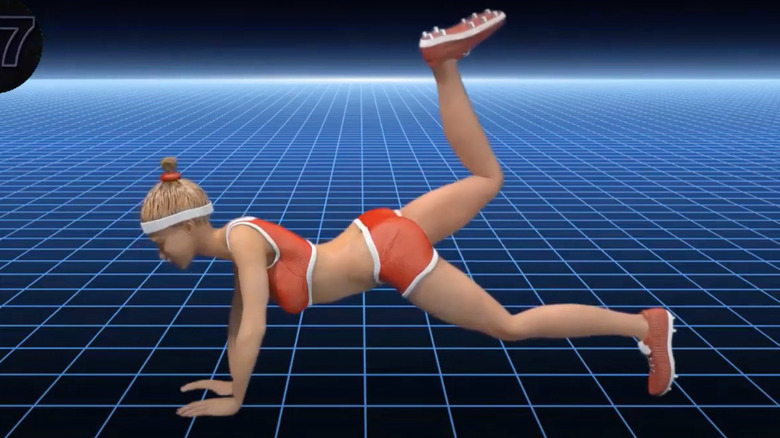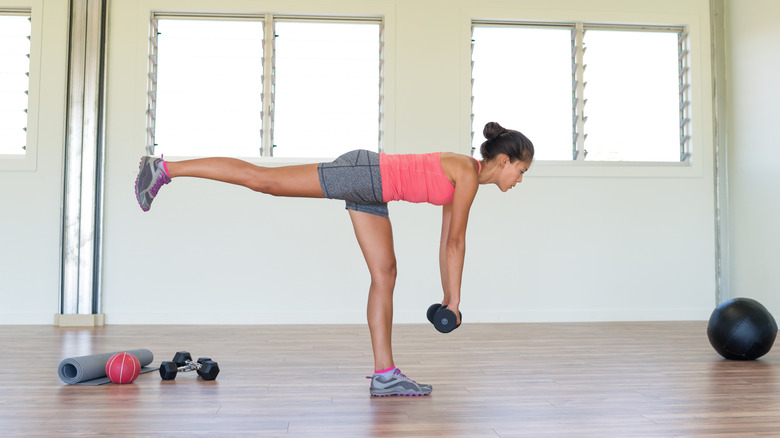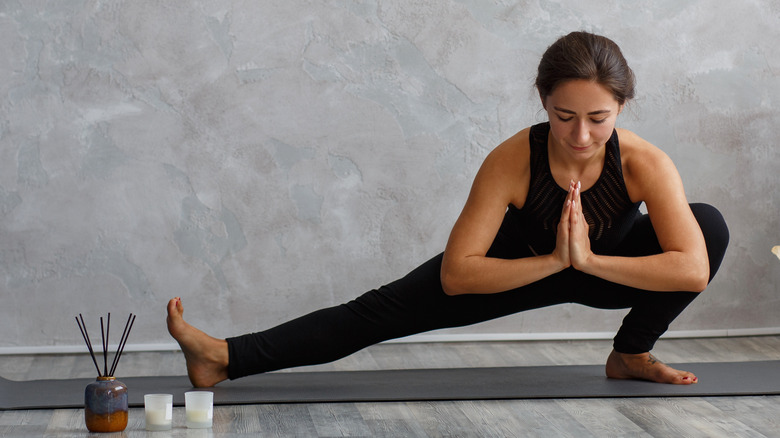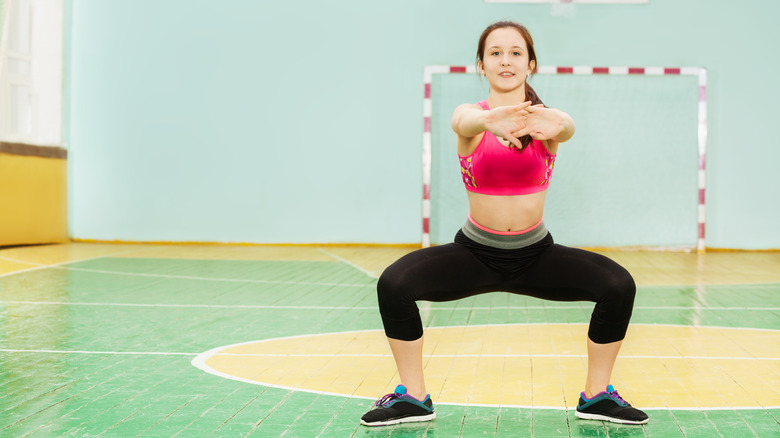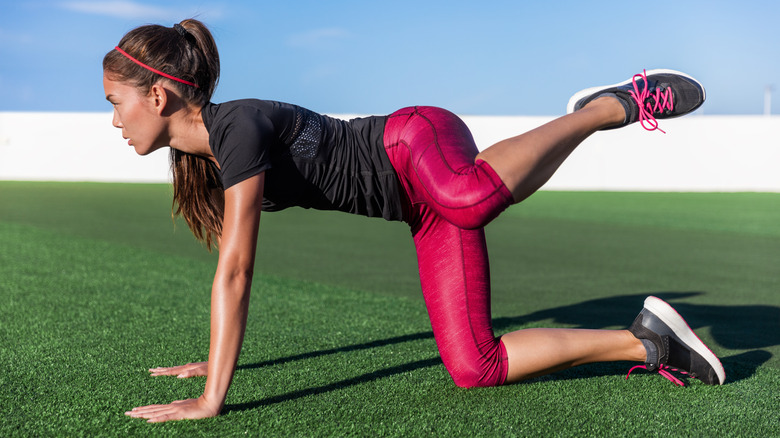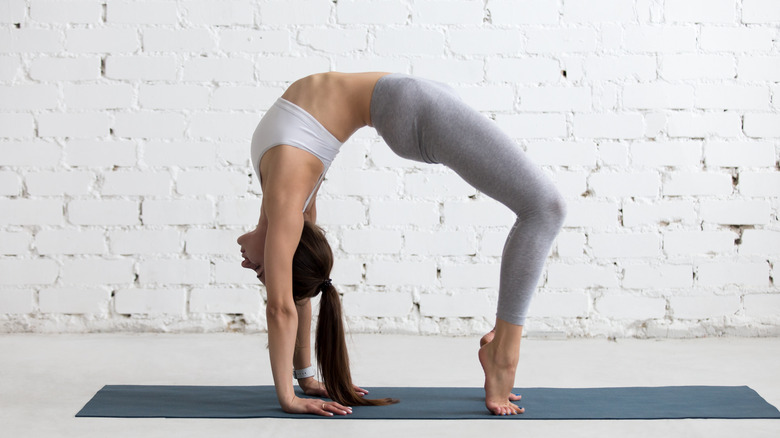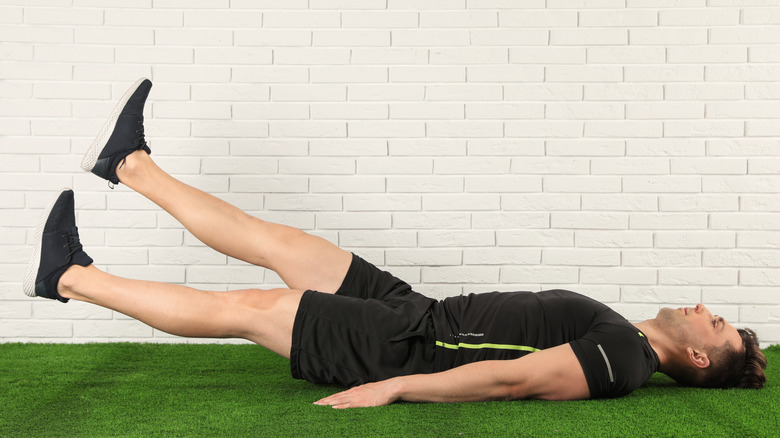The Best Butt Exercises You Probably Aren't Doing
If you're in pursuit of a more toned butt, it's time to mix it up. Common knowledge teaches us that if you want to work your butt, exercises like lunges and squats are the way to go — and to a large extent, that's true. The squat, for example, is efficient, simple, and gives your lower body and your inner muscles a great core workout, according to the owner of Trooper Fitness and trainer on Daily Burn 365 Prince Braithwaite, according to Daily Burn. In addition, squats are also huge calorie-burners, "due to the fact that you engage several large muscle groups during the movement," says Braithwaite.
We all know that, right? We know that regular squats are great. But, they're also (whisper) pretty boring. And, the fact of the matter is, there are dozens of exercises out there that can not only target your butt but revolutionize your workout, keeping you interested and stopping you from having to summon all of your inner strength to squat for the thousandth time. Here at Health Digest, we wanted to mix it up and show you some of the best little-known butt exercises that'll set your glutes on fire — with a couple of squat variations thrown in. Just because, y'know?
The rainbow will get your glutes going
This little-known exercise is not only guaranteed to fire up your glutes, but also comes with a pretty solid celebrity endorsement. The rainbow is a favorite of supermodel Adriana Lima, according to Self. We'd say that's a recommendation we can trust.
What's more, "The rainbow is an incredible way to work your booty from all angles without overworking your quads or hamstrings," says Katie Dunlop, Love Sweat Fitness creator. To perform the exercise, place yourself on the floor on all fours, with one leg extended to the side, as Women's Health advises. Then, lift your leg while engaging your glutes and keeping your toes pointed, and move it in an arch (or rainbow) shape to the other side, squeezing at the top. Repeat in the other direction, and then back, until your reps are completed.
This exercise also has an advantage in that it'll engage your abs as well as your glutes. To get the maximum from this move, try performing three sets of 15 reps for each side. Or, to really test yourself, try performing it kneeling on a box, as Lima does — this will "challenge your flexibility and strength more than simply performing it on all fours on the floor," states Dunlop.
Skater squats are a glute-focused squat variation
It wouldn't be a butt workout without a few squats, but we'll spare you the standard type and go straight for this killer variation. The skater squat will particularly challenge your glutes as well as your quadriceps, according to Healthline, and is a particularly challenging squat variation that'll get your muscles burning.
To do a skater squat, stand with one leg behind you, floating, either bent or straightened. With the regular leg, bend it at the knee in a squat motion, keeping the leg behind you either in the air or lightly touching the ground (i.e. not bearing any weight — this shouldn't turn into a squat). Once you've reached your lowest point with the bent leg, return to standing. To keep yourself balanced while doing it, keep your core engaged, and if you like you can hold your arms out in front of you for a counter-balance.
This exercise is best performed for five to 10 reps in three to four sets for maximum results. As this exercise can be challenging balance-wise, start with your bodyweight first to make sure you're nailing your form; once you're confident with how you're performing the move, you can start to add in weights.
The clamshell will work your glutes and help protect your lower back
So it might not be the most glamorous name for an exercise in the world, but the clamshell is a hidden pearl. This exercise will work your glutes and hip muscles, as well as help to ease lower-back tension and pain and to help safeguard against injury, according to Healthline.
To do the clamshell, lie on your side with your legs together, bent to a 45-degree angle, and with your head propped up on your hand. Make sure that your top hip isn't rocking backward, and that your body is perpendicular to the floor. Then, engage your core and, keeping your feet together and without moving your pelvis or your hips, raise your upper knee to the highest it can go. Make sure that your lower leg doesn't travel with it, and stays on the floor. Pause at the top and then lower your lower leg back down to meet your other knee, and repeat for 20 reps.
You can perform this exercise fairly gently if you feel like it, or ramp up the intensity to really feel the burn. To add a little extra to the move, use a resistance band around both of your legs, just about the knee.
Single-leg glute bridges target your glutes effectively
Most people know that a glute bridge is a great exercise for your butt, but performing a variation can make your glutes positively pop. Such is the case with a single-leg glute bridge, which is particularly good for those home workers out there. "This move is great for any desk-bound worker because it improves hip mobility and lower-back strength," says fitness instructor Whitney Johns, who works with Plankk Studio, a personal training app, to Women's Health Magazine. "Sitting at a desk really weakens glutes and can lead to lower-back problems." We can attest to that!
Lie with your back on the floor, with your knees bent and placed on the floor around a foot or so away from your butt, as though you were about to do a standard glute bridge. Then, raise one leg straight up into the air, until it's in line with your hips (your foot can remain flexed here). Using the foot that's still on the ground, push your hips up, keeping your upper back on the floor, until your upper body's in a straight line and your glutes are well-elevated. Squeeze your glutes for a few seconds at the top, and then slowly lower your butt to the ground. Repeat for three sets, 15-20 reps on each side.
Watch your form when doing single-leg hip thrusts
This move is kind of like a next-level single-leg glute bridge, and all you'll need to do it is an exercise bench or box. With your feet up on the bench and your knees bent, lie with your back flat on the floor, according to Men's Health. Then, lift one of your feet off the box, allowing it to be elevated slightly. Use the foot still on the box to push your hips upward, pausing at the top to activate your glutes. Then slowly lower your hips and your body back to the first position. Complete for as many reps and sets as you wish, and then switch legs.
Doing any muscle-strengthening exercise will test your body, and so make sure that your form is correct when performing this exercise, trying not to hyperextend your back, as Healthline points out. In addition, try to focus on contracting your glutes at the top, to make sure you're getting the most out of the exercise (as well as staying focused on those muscles so your body doesn't compensate by using back or leg muscles). Single-leg hip thrusts will also work your hamstrings too, as a little bonus, according to Verywell Fit.
Curtsy lunges are excellent for your butt
The curtsy lunge is basically a direct line to a stronger butt, as Lacey Stone, star of "Revenge Body" and celebrity fitness trainer can attest. "Adding a curtsy lunge to your workout routine is a great idea, because it focuses on different muscles than a regular lunge," she says, "and will aid in an even perkier bottom." Not only does it fire up your glutes, but it also helps to tone your inner thigh, a hard-to-reach muscle — so this is one you'll definitely want to incorporate.
To do the move, place your hands on your hips and stand with your feet hip-width apart. Step back with one foot and, instead of going directly backward as you would in a reverse lunge, move your leg behind the other, in a curtsy motion. Keeping your core engaged, bend your forward knee and lower your hips in a lunge motion. Try not to rotate your body during the move. Then, return to a standing position and repeat with the other leg, for one rep. Try and do 8-10 reps per set and, if you really want to challenge yourself, use a weight while you're doing them, says Stone.
Landmine deadlifts are great for people with back problems
Don't let the hardcore name intimidate you: the landmine deadlift is actually a safer variation of a deadlift, due to the barbell that you use to do it staying connected to the floor on one side at all times, meaning you have a fixed range of movement, according to Boots Up Fitness. So, this move is perfect for deadlift beginners, or anyone who wants to avoid putting too much strain on their back or spine.
This move is best done at a gym unless you have access to a landmine unit (via Stack) and a barbell at home (you can also place one end of the barbell in the corner of a room to do this). Put one end of a barbell in the unit, and put your weights on the other end closest to you, as Muscle & Fitness states. With your feet shoulder-width apart, bend at the knees and hips and grip the weighted end of the bar, making sure you have a flat back. Take a deep breath, rotate your feet outward, and then push your legs and hips up, lifting the weight off the floor. Once you're upright, slowly lower the weight back down for one rep.
Bear plank leg lifts work your glutes and other muscles
The bear plank is a plank variation that targets a massive amount of muscles: not only your abs, as with a regular plank, but also your shoulders, arms, quadriceps, psoas, and our main focus here, the glutes, according to VeryWell Fit. The bear plank leg lift can take this glute activation to the next level, and make this an exercise that focuses on one part of your body while working many others.
To begin this exercise, get yourself into a bear plank by starting in a tabletop position, and then pushing with your feet and hands to lift your knees 3-6 inches from the floor (keeping your core engaged, of course). Then, lift one of your legs off the ground, bending it at the knee so your foot comes towards your butt. Keep your foot flexed, and lift your elevated foot towards the ceiling, engaging your glutes while you do so. Pause at the top, and then return your elevated foot to the ground. Repeat 8-10 times for one set, for however many sets you need.
Single-leg deadlifts will challenge your stability
If you like deadlifts, you're gonna love this one. The single-leg deadlift is a variation that not only targets your glutes way more effectively than a regular deadlift but also challenges your balance and stability. It also puts way less stress on the spine due to using much less weight, as strength and mobility coach for San Diego-based company Pippin Performance, Matt Pippin, says to Women's Health.
To perform the exercise, stand with your feet hip-width apart and pointing forwards and, if you're using weights, hold them down in front of you, according to Class Pass. Shift your weight onto one leg and start to lean forward, extending the other leg behind you. Allow your upper body to shift forward and down while your leg rises behind until you're making a T-shape with your body. Make sure your standing leg is bent slightly, while your weights are gripped firmly in your hands, extending towards the floor. Then, slowly return to standing. As Pippin states, in the middle of the exercise, "The hip has a tendency to roll up toward the ceiling — you want to prevent it from rotating at all."
You need to get low with a Cossack squat
The cossack squat is, if you think about it, a variation on a variation: cossack squats are very similar to side lunges, which are, in themselves, a variation on lunges. (It's all getting very "Inception"-y in here!) Where the difference lies, according to Healthline, is that cossack squats begin with a very wide leg stance, and you have a license to drop as low as you can when performing the move.
To do a cossack squat, start with your feet wide apart, forming a triangle, with your feet pointing forwards. Move your weight onto one leg while inhaling, and bend the knee of that leg, while keeping your body sat back as far as possible. Keep the other leg extended as you lower down to the ground, turning the foot of the extended leg turned up. Try and make sure that the heel of the bent leg stays connected to the ground, and that your body stays upright. Pause when you're at your lowest, and push back up to your starting position, exhaling as you do so. Repeat on the other side, aiming for five reps for each leg for three sets.
Go wide with your sumo squats
Sumo squats are what you need to up your squat game. As well as being a supreme squat variation to target your butt, "The biggest benefit to doing sumo squats is that the wider stance offers a unique challenge to the inner thigh muscles, or your adductors," says owner of New York-based Power Health and Performance and certified strength and conditioning coach John Calarco to Women's Health Magazine. Adductors can be tricky to train, meaning the sumo squat is a double-duty move.
To do a sumo squat, you've got to start wide. Begin by placing your feet wider than hip-width on the floor, with your toes pointed out 45 degrees, and your torso leaning forward slightly. Then, bend your knees as you would in a normal squat, inhaling as you do so until your thighs become parallel to the floor. As you push back up, exhale, and return to starting position. Repeat for eight to 15 reps, for however many sets you require. If you want to make it even more challenging, you can use a kettlebell or dumbbell, and hold it between your legs in your hands as you perform the exercise.
Fire hydrants are great for loosening up your hips
We're not gonna lie: no one looks graceful doing a fire hydrant. The move is called that to mirror when dogs pee against them, just so you know what you're getting yourself into. But, this exercise is a sure-fire way to get some rock-solid glutes, working all three of your glute muscles as well as your hips and core, says Women's Health Magazine.
To begin, get yourself into a tabletop position on the floor, with your arms and legs stacked under your shoulders and hips and perpendicular to the floor, like Love to Know shows. Make sure that your core's engaged and your back is flat. Then, lift one of your knees up and out to the side, until it's parallel to the floor (so that you mimic a dog ... you know). Try and keep your hips as still as possible during this. Return to the starting position, and that's one rep.
When you're doing this exercise at first, it's normal for your hips to be a little tight or hard to move to get your leg parallel to the floor. If that's the case, lift to as high as is comfortable; the more you do this exercise, the more flexible your hips will become.
Go back to your childhood with a full bridge
You might not have done one of these since you were a kid but, once you see the effect it has on your glutes, you won't be able to stop. If you need a reminder as to how it's done (or just want to make sure your form is perfect), lie on your back, with your feet planted on the floor and your knees up, as Lifehack states. Then, take your hands and place them on the floor, with your fingers pointing towards your shoulders. With your hands and your feet, push yourself up into a full bridge. Hold it for as long as you can, but ideally no longer than three minutes, as it can cause a headrush.
In addition to working your glutes, your back and abdominal muscles will also be activated by this move, as Fitstream points out. Bear in mind that you'll need good shoulder and wrist flexibility to be able to do a full bridge; if it feels a little advanced at the moment, try a short bridge (or glute bridge) instead. Instead of pushing up with your hands, keep them to your side, and push up onto your upper back. This will still give your glutes a great workout.
Flutter kicks work your glutes and your abs
Primarily thought to be an abdominal exercise, flutter kicks are an effective way to tone up your derriere, as well as your quads and hip flexors, says Greatist. To do a flutter kick, lie flat on your back with your hands on either side, palms down to stabilize. Raise your legs until they're at about a 45-degree angle with the floor, with a slight arch in your lower back. Keeping your legs together as much as possible, point your toes, and start fluttering your legs up and down, as though you're kicking lightly through the water. One full flutter with each leg is one rep; try them for three sets of 10 reps.
Try and keep your spine neutral as much as possible when performing flutter kicks and, as this is a fairly advanced exercise to do, if it's uncomfortable or painful, try elevating your legs higher up. And, if you want a variation that really targets the glutes, try a reverse flutter kick: the same exercise, but lying on your front instead of your back, as Coach shows. It's good to reverse flutter kicks lying on a bench, as you'll get a better range of motion.

